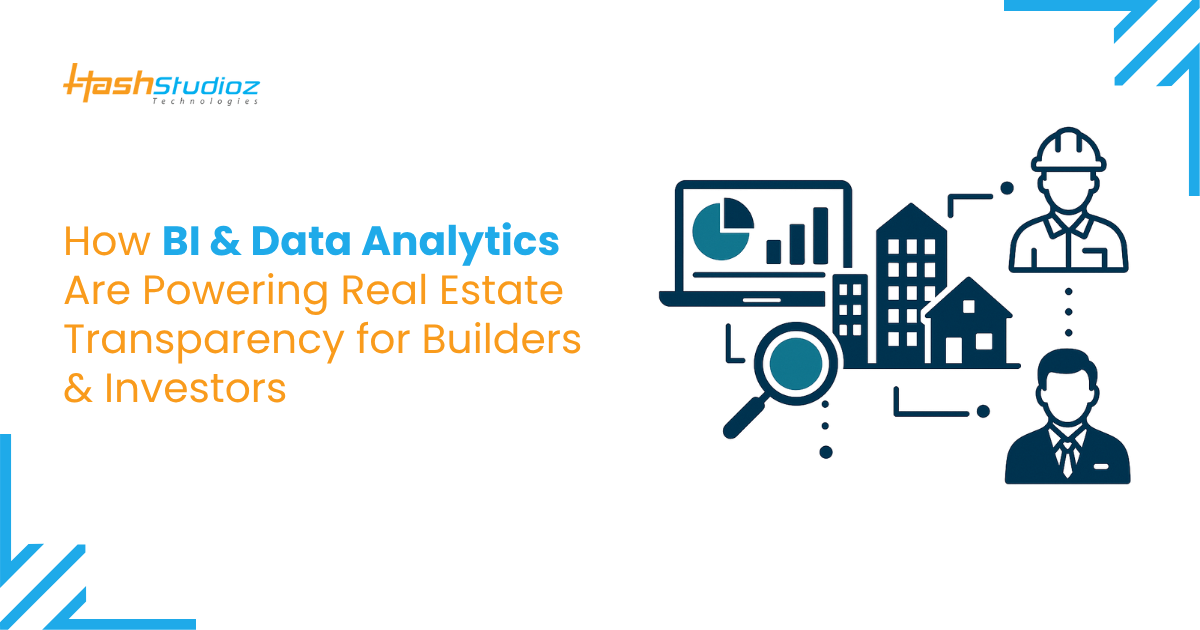In today’s fast-evolving real estate sector, data is more than just a record—it’s a strategic asset. From buyer behavior to property inventory, real-time analytics can unlock critical insights for builders and investors alike.
At HashStudioz Technologies, we recently partnered with a real estate record-keeping firm that was grappling with a familiar challenge: fragmented data, manual Excel workflows, and delayed reporting cycles. The solution? A robust Business Intelligence (BI) and analytics dashboard that now empowers their clients—builders and investors—with timely insights and full project visibility.
Let’s dive into how our BI transformation reshaped their operations.
Table of Contents
The Problem: Siloed Data, Delayed Decisions
The client, a leading real estate data custodian, was managing records for multiple builders and investment partners. However, their data existed in scattered formats:
- Excel sheets for unit-wise details
- Email chains for payment schedules
- PDFs for customer segmentation reports
- Internal tools for tracking investments
This lack of unified reporting made it tough for builders to track project performance, and even harder for investors to assess risk, ROI, and sales velocity.
The Solution: A Unified Real Estate BI Dashboard
HashStudioz designed and implemented a centralized BI solution that aggregated data from various sources into an interactive dashboard. The system was built on modern tools like Power BI and PostgreSQL, with automated ETL pipelines to ensure daily data refreshes.
Key Modules Delivered:
- Inventory Insights
- Property type (1BHK, 2BHK, commercial, etc.)
- Unit status (sold, booked, available)
- Location and tower-wise filtering
- Customer Segmentation
- Demographics (age, income bracket, geography)
- Buying patterns (first-time buyers, investors, repeat customers)
- Custom marketing personas
- Pricing & Investment Analytics
- Price per sq. ft. trends
- Investment inflows per project
- Builder vs. investor contribution
- Payment Schedule & Cash Flow
- Upcoming vs. overdue installments
- Dynamic payment status per customer
- Projected vs. actual revenue tracking
- Investor Portfolio View
- Project-wise investment overview
- ROI visualization
- Alerts for risk flags and overdue payments
How We Solved It – Technical Deep Dive
To bring this vision to life, our team followed a structured data architecture and dashboard delivery pipeline. Here’s how we broke it down:
1. Data Extraction and Integration
- Connectors & APIs: We built custom connectors to ingest data from Excel files, Google Sheets, and the client’s legacy tools.
- Document Parsing: Used Python-based extractors (pandas, tabula-py) to parse tabular data from PDFs (for old contracts and payment schedules).
- Database Layer: Centralized all cleaned data into a PostgreSQL data warehouse on AWS RDS for scalability and secure access.
2. Data Modeling & Governance
- Star Schema Models: Created clean, query-efficient fact-dimension models for inventory, customer, transaction, and project data.
- Data Validation Layer: Used dbt (Data Build Tool) to define transformation logic and implement business rules (e.g., “flag overdue if payment date > today”).
- Role-Based Access Control: Ensured that builders only see their own project data; investors only see portfolio-level aggregated insights.
3. Dashboard Layer with Power BI
- Developed interactive dashboards using Power BI Embedded, giving the client the flexibility to:
- Filter by project, date range, customer profile
- Visualize trends over time (inventory movement, pricing, cash inflow)
- Drill down from summary to unit-level details
- Enabled scheduled refresh using Power BI gateway for near real-time updates.
4. Deployment and Automation
- CI/CD pipelines using GitHub Actions for automated deployment of dbt models and SQL scripts.
- Scheduled ETL jobs (using Apache Airflow) to pull daily data and push to Power BI datasets.
- Notification System integrated with email alerts for payment due reminders and anomaly detection (e.g., sudden sales drop).
Business Impact: From Reports to Real-Time Intelligence
The impact was swift and measurable:
- 90% reduction in manual report creation time
- Real-time dashboards led to faster investor briefings
- Builders could pre-empt delays in cash flow with proactive alerts
- Investors gained portfolio-level clarity, improving trust and retention
Why Choose HashStudioz for Real Estate BI?
Our strength lies in domain-centric BI delivery. We understand that builders and investors don’t need raw data—they need actionable stories. With deep experience in real estate, financial analytics, and interactive dashboarding, we:
- Customize KPIs based on business models
- Ensure data security with role-based access
- Offer multi-device dashboards (laptop, tablet, mobile)
- Provide post-deployment support & scaling options

Final Thoughts
As real estate investment grows more competitive and data-rich, the ability to synthesize and act on insights becomes a major differentiator. With the right BI tools, firms can transform passive records into active strategy.

